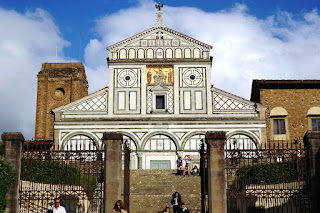After crossing the Arno, Edward Hutton climbed the lovely Hill of Gardens, and then came to the beautiful ancient church of S. Miniato where he paused to describe a beautiful tomb.
Then, turning into Via Romana, you come, past the gardens of S. Piero in Gattolino. To the Porta Romano, the great gate of the Via Romana, the way to Rome, and before you is the Hill of Gardens, and behind you is the garden of the Pitti Palace, Giardino di Boboli, and farther still, across Via Romana, the Giardino Torrigiani.
The Boboli Gardens, with their alley ways of ilex, their cypresses and broken statues, their forgotten fountains, are full of sadness--… But the gardens of the Viale are in spring, at any rate, full of the joy of roses, banks, hedges, cascades of roses, armsful of them, drowsy in the heat and heavy with sweetness.
“I’mi trovai, fanciulle, un bel mattino
Di mezzo Maggio. In un verde giardino.”…
Certainly to-day there is nothing more lovely in Florence in spring, and in autumn too, than this Hill of Gardens. In autumn too; for then the way that winds there about the hills is an alley of gold, strewn with the leaves of the plane-trees that the winds have scattered in countless riches under your feet; that whisper still in golden beauty over your head. There, as you walk in spring, while the city unfolds herself before you, a garden of roses in which a lily has towered, or in the autumn afternoons when she is caught in silver mist, a city of fragile and delicate beauty, that is soon lost in the twilight, you may see Florence as she remains in spite of every violation, Citta dei Fiori, Firenze la Bella Belissima, the sweet Princess of Italy. And, like the way of life, this road among the flowers ends in a graveyard. The graveyard of S. Miniato al Monte, under which nestles S. Salvatore, that little brown bird among the cypresses, over the grey olives. [
Church of S. Miniato.
It is the most beautiful of the Tuscan-Romanesque churches left to us in Florence; built in 1013 in the form of a basilica, with a great nave and two aisles, the choir being raised high above the rest of the church on twenty-eight beautiful red ancient pillars, over a crypt where, under the altar, S. Miniatio sleeps through the centuries. The fading frescoes of the aisles, the splendour and quiet of this great and beautiful church that has guarded Florence almost from the beginning…have a peculiar fascination, almost ghostly in their strangeness, beyond anything else to be found in the city. And if for the most part the church is so ancient as to rival the Baptistery itself, the Renaissance has left there more than one beautiful thing….
In the left aisle is the chapel, built in 1461 by Antonio Rossellino, where the young Cardinal Jacopo of Portugal lies in one of the loveliest of all Tuscan tombs, and there Lucca della Robbia has placed some of his most charming terracottas, and Alessio Baldovinetti has painted in fresco. In all Tuscany there is nothing more lovely than that tomb, carved in 1467 by Antonio Rossellino for the body of the young Cardinal. But twenty-six years old when he died, “having lived in the flesh as though he were freed from it, an Angel rather than a man.” Over this beautiful sarcophagus, on a bed beside which two boy angels wait, the young Cardinal sleeps, his delicate hands folded at rest at last. Above, two angels kneel, about to give him the crown of glory which fadeth not away, and Madonna borne from heaven by the children, comes with her Son to welcome him home. There, in the most characteristic work of the fifteenth century, you find man still thinking about death, not as a trance out of which we shall awaken to some terrible remembrance, but as sleep, a sweet and fragile slumber, that has something of the drooping of the flowers about it, in a certain touching beauty and regret that is never bitter, but, like the ending of a song or the close of a fair day in spring, that rightly, though not without sadness, passes into silence, into night, in which shine only the eternal stars.
###
Edward Hutton: Florence and Northern Tuscany with Genoa, second edition, London, 1908. Pp. 270-4.







































